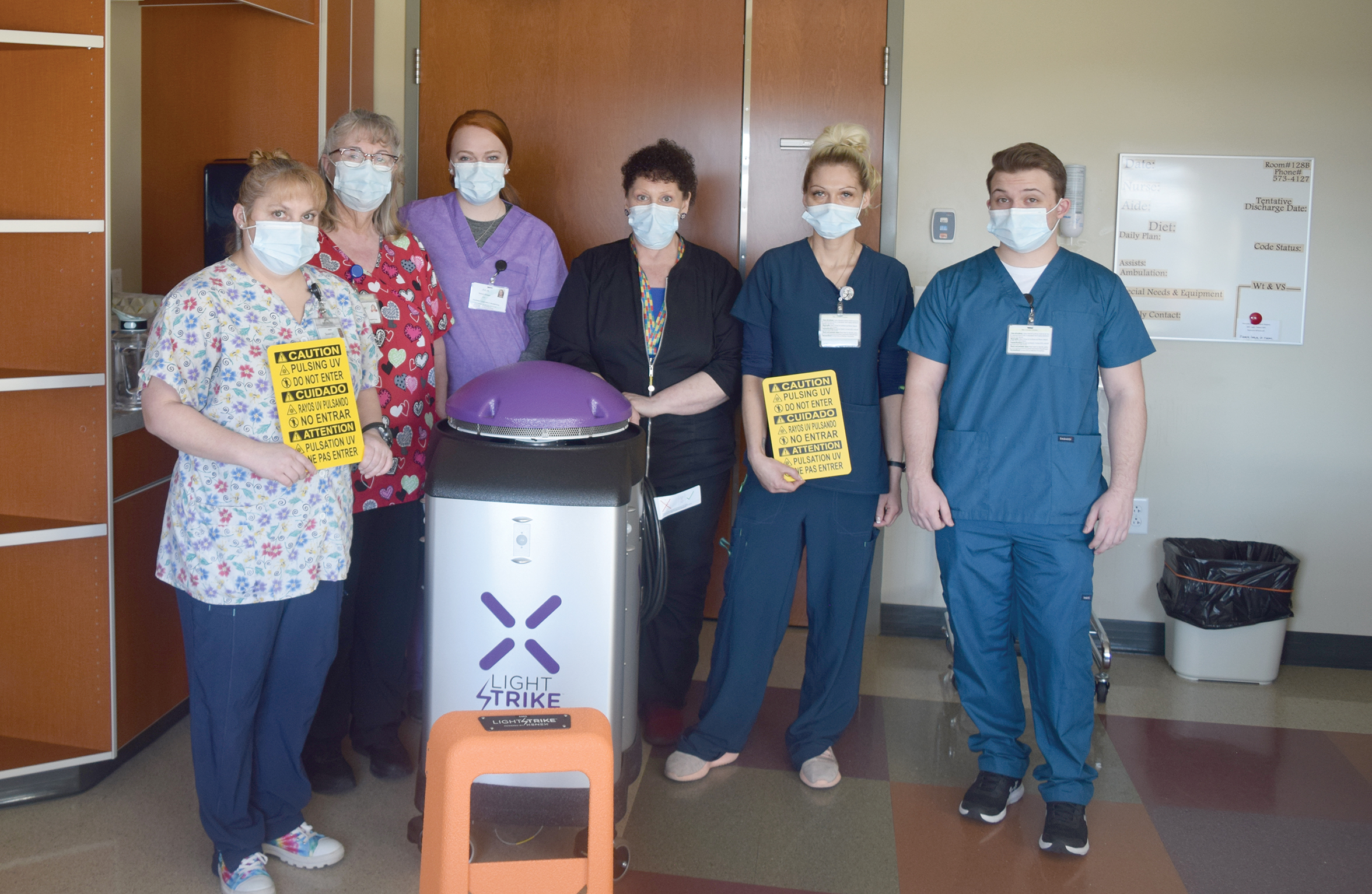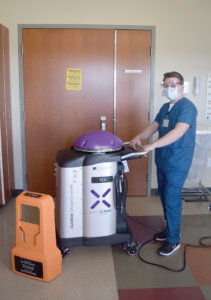
28 Feb Harney District Hospital enhances facility’s cleanliness with a pair of germ-zapping robots
A few members of the Harney District Hospital Environmental Services team pose with ‘Tex,’ one of the facility’s new LightStrike Germ-Zapping robots. Pictured from L-R: Shantel Jenkins, Jackie Dickenson, Julia Larkin, Manager Kathy Byram, Amber Montague, and Sam Grigg.

Sam Grigg demonstrates how ‘Tex’ destroys pathogens.
They glide through halls, easily slaying superbugs and never fail to light up a room. Perhaps you’ve spotted them wheeling around Harney District Hospital (HDH) or HDH Family Care between assignments.
These automated disinfection devices are like pathogen assassins, and they recently joined the HDH Environmental Services (EVS) team in the fight against viruses and bacteria!
Safety is one of HDH’s core values. As hospitals look for new and innovative ways to stop the spread of germs, HDH has taken high-tech measures with the deployment of two LightStrike Germ-Zapping Robots that quickly destroy viruses and bacteria in hard-to-clean places. The robots are proven to deactivate SARS-CoV-2, the virus that causes COVID-19, in 2 minutes!
“The robots are a great addition to HDH’s EVS team,” Manager Kathy Byram said. “While EVS has always followed policies and procedures when cleaning the hospital, it is an added comfort knowing that the robots’ laser-light technology disinfects microscopic germs we may have missed on doorknobs, floors, and anything else in the room.”
The pandemic has people very aware of the threat of disease transmission. Some viruses and bacteria are becoming resistant to cleaning chemicals, antibiotics, and even hand sanitizers, so forward-thinking hospitals like HDH are turning to new technology to enhance their cleaning and sanitation practices.
LightStrike robots pulsed xenon to create intense bursts of ultraviolet (UV) light that quickly destroy bacteria, viruses, and spores on surfaces. The robots work quickly and do not require warm-up or cool-down time, so EVS staff are able to disinfect several rooms each day.
Viruses and bacteria are vulnerable to UV light at various wavelengths. The broad spectrum UV light emitted by a LightStrike robot hits pathogens where they are most vulnerable. The robots have been proven effective against the most common — as well as the most dangerous — pathogens, including SARS-CoV-2, influenza, MRSA, and C.diff. More than 45 peer-reviewed studies have been published by healthcare facilities validating the efficacy of the LightStrike robot technology.
The portable LightStrike robots run in 5-minute cycles and can disinfect a typical patient room in 10-15 minutes without warm-up or cool-down times. Operated by our EVS team, the robots can be used in our hospital and clinics, including isolation rooms, operating rooms, general patient care rooms, contact precaution areas, emergency rooms, offices, conference rooms, restrooms, and more.
Use of the LightStrike robots enhances the hospital’s already thorough processes for cleaning rooms and destroying the pathogens that can cause infections. The robots are part of the EVS team and did not replace any employees.
“To kill any viruses that may be lurking in a room, the EVS team will set up a robot in a discharged room before we clean it,” Byram said, explaining that this is an extra precaution to keep staff safe. “After the robot has shut off, we will go in and clean the room following our policies and procedures.”
After the robots are deployed, a typical cleaning is conducted. All visible dirt/fluids are removed, trash is emptied, linens are removed, etc. Once the room is visually clean, EVS staff deploy a robot again to destroy any microorganisms that may have been missed.
“Following all of these procedures makes the EVS team feel confident that HDH is clean and safe for all patients as well as employees and their families,” Byram said.
Germs, beware! Armed with this new technology, HDH’s EVS team is ready to destroy the deadly pathogens that the naked eye can’t see.

No Comments